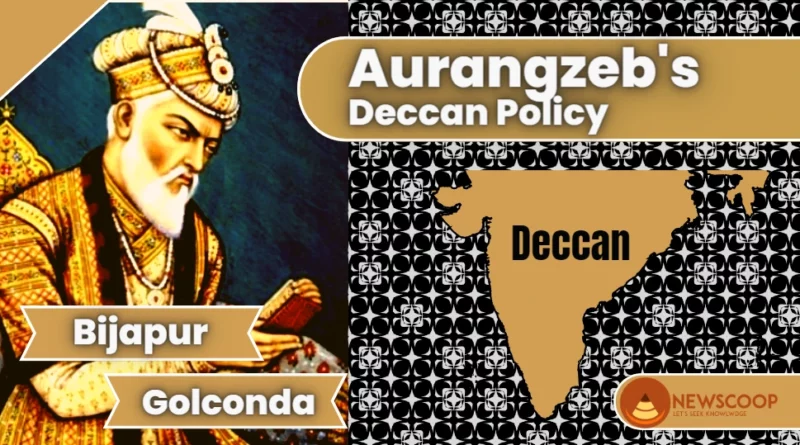Deccan Policy of Aurangzeb – Most Important Fact & Objective [100% UPSC]
Aurangzeb’s Deccan Policy was a strategy of expanding the Mughal Empire’s territory in the Deccan Plateau region through military campaigns and administrative measures. Its objectives included controlling local kingdoms, trade routes, and regional powers, spreading Islam, and establishing efficient administration.
Deccan Policy of Aurangzeb
Aurangzeb was a supporter of expansionist and imperialist policies. With his North West, North East frontier campaigns, and South campaigns, he made his empire more vast and expanded. Of all these campaigns, the longest campaign was in the south.
From the very beginning, the Mughals wanted to strengthen their position in South India, but they could not succeed. Seeing the failure of his ancestors, Aurangzeb threw all his energy into the Deccan campaign. Let’s know more about the Deccan Policy of Aurangzeb.
| Emperor | Aurangzeb |
| Campaign | Deccan |
| Year | 1682 |
| Motive | Expansion |
| Location | Deccan |
| Approach | Military |
| Objectives | Control, expansion, authority, trade, conversion, and administration. |
| Consequences | Weakening, decline, resistance, legacy |
Objectives of the Deccan Policy of Aurangzeb
The following are the Objectives of the Deccan Policy of Aurangzeb:
- Expand Mughal Empire into Deccan.
- Control local kingdoms and rebellions.
- Control strategic trade routes.
- Assert Mughal authority over regional powers.
- Spread Islam and convert non-Muslims.
- Establish efficient administration in the Deccan.
Phases of Aurangzeb’s Deccan Policy
Historians have divided the Deccan Policy of Aurangzeb into three phases:
- First Phase till 1668:In the first phase, Aurangzeb wanted to take back from Bijapur those areas of Ahmednagar that the Mughals had given to Bijapur under the treaty of 1636.
- Second Phase till 1681: In the second phase, Aurangzeb won Bijapur and Golconda in his favor against Shivaji.
- Last Phase till 1687: In the third and last phase of the Deccan Policy of Aurangzeb, after conquering Bijapur and Golconda, he fought against the Marathas for the rest of his life.
First Phase
- There was a treaty between Shah Jahan, Bijapur, and Golconda in 1636 AD, according to which Shahjahan gave them one-third of the territory of Ahmednagar and took a promise from him that he would help the Mughals against the Marathas.
- Further, Shahjahan assured Bijapur and Golconda that he would never attack them. But Shahjahan broke the terms of the treaty and threatened to attack in 1657-58. In addition to this, he justified his action on the ground that Bijapur and Golconda occupied vast areas of Karnataka.
- This was possible because the Mughals remained neutral, besides this they also needed money. So he asked back those areas of Ahmednagar.
- Aurangzeb wanted Adilshah’s cooperation against the Marathas, but Adilshah adopted a non-cooperative attitude.
- Jaisingh advised Aurangzeb that the problem of Marathas cannot be solved without a fully aggressive policy.
- Jai Singh had advised Aurangzeb to win Bijapur because Bijapur was like a victory gate of the entire Deccan and Karnataka. But Aurangzeb was hesitant to send a long military expedition to Bijapur because of the threat from the northwest.
- Further, it was necessary for him to stay with a large army and he did not want to leave the capital.
- Jai Singh had to attack Bijapur in 1665 with limited resources but he failed.
- Aurangzeb wanted to get Solapur by any means, so he got Solapur in 1668 by bribing.
Also Read: Rajput Policy of Akbar
Second Phase
- In the second phase, Aurangzeb started interfering in Bijapur’s politics after seeing the internal situation.
- He chose the Afghan Sardar Diler Khan because Diler Khan had good relations with the Sardars of Bijapur.
- He invaded Golconda in 1677 by taking the Afghans of Bijapur to his side, but Madonna and Akhanna defeated the combined forces of the Mughals and Bijapur.
- Since Golconda had welcomed Shivaji with an open heart, Shivaji also helped Golconda, now Bijapur has left alone in Deccan, whom the Mughals wanted to take advantage of.
- On this, Bijapur sought help from Golconda. Further, Qutb Shah of Golconda put some conditions in return for his help, which was extremely humiliating, but still, the Afghans accepted it.
- Golconda’s influence in the Deccan was at its zenith. At the same time, Masud was made the deputy ruler of Bijapur, he tried to establish peace with the Mughals by meeting Diler khan.
- Aurangzeb decided to attack Bijapur in 1679. But the Mughal army failed in this and had to return back.
- Taking advantage of this opportunity, Shivaji started attacking Mughal territories.
Last Phase
- The third and final attempt at Aurangzeb’s Deccan policy began in 1681 when his rebellious son Akbar took refuge with the Marathas in the Deccan.
- Aurangzeb followed him to the Deccan and threw all his might against Shivaji’s son Sambhaji but could not succeed.
- South states knew that Marathas are like their shield, as long as Marathas are powerful, their survival is possible. Otherwise, the Mughals would erase their existence, that’s why Bijapur and Golconda did not support Aurangzeb.
- Aurangzeb was very angry about this and attacked Bijapur. The rulers of Bijapur sought help from the Marathas and Golconda, both of which provided them with prompt assistance.
- Now the joint army of all three together faced the Mughal army, but the joint front of all three with Aurangzeb’s huge organized army also failed.
- In 1686, Bijapur was annexed to the Mughal Empire, after which the Mughals invaded Golconda, defeated Golconda, and exacted a large amount of indemnity, and Aurangzeb assured Golconda forgiveness.
- But Golconda could not escape from the clutches of the Mughals. In 1687, Aurangzeb invaded Golconda and annexed it to the Mughal Empire.
- The Marathas were left in South India after the Golconda and Bijapur kingdoms came under the Mughals. Aurangzeb put all the power against the Marathas, he killed Sambhaji which was his biggest mistake because this murder made the Marathas more fierce and they became staunch enemies of the Mughals.
- Aurangzeb kept attacking regularly to end the Marathas but he did not get success.
- At last Aurangzeb, dejected, returned to Aurangabad where he died in 1707.
Also Read: Religious Policy of Akbar
Conclusion to the Deccan Policy of Aurangzeb
Thus, the Deccan campaign proved to be grave for Aurangzeb, he certainly expanded the empire by conquering the south but failed to maintain it. Aurangzeb left a vast and internally weak empire behind him, so if it is said that Aurangzeb’s Deccan policy became responsible for the downfall of the Mughal Empire, then it would not be unfair.
So, this is all about the Deccan Policy of Aurangzeb. If you like this article, please share it with your friends.
Thank You!
What was the Deccan Policy of Aurangzeb?
Aurangzeb’s Deccan Policy was his military campaign aimed at expanding the Mughal Empire into the Deccan Plateau region of India.
When did Aurangzeb launch his Deccan Policy?
Deccan Policy of Aurangzeb was launched in 1682 after he had consolidated his power in the north and had become the emperor of the Mughal Empire.
What was the Main Objective of the Deccan Policy of Aurangzeb?
The main objective of Aurangzeb’s Deccan Policy was to establish Mughal dominance over the Deccan Plateau region and to suppress the local kingdoms and rebellions.
Related Links:

